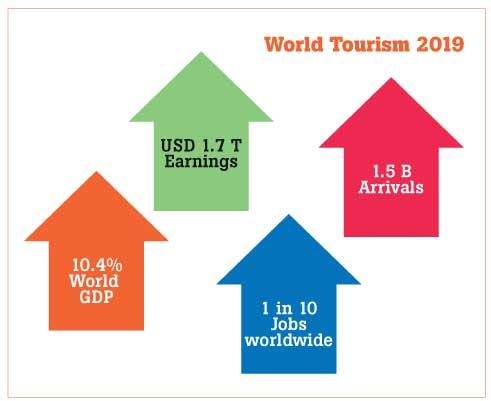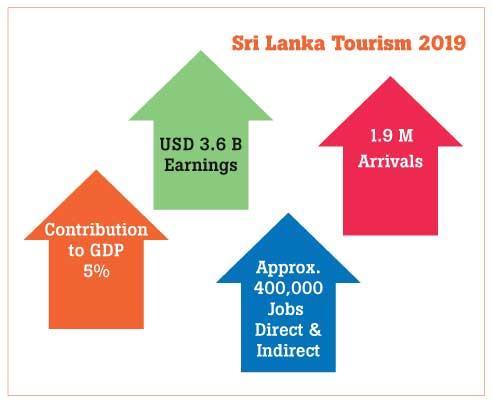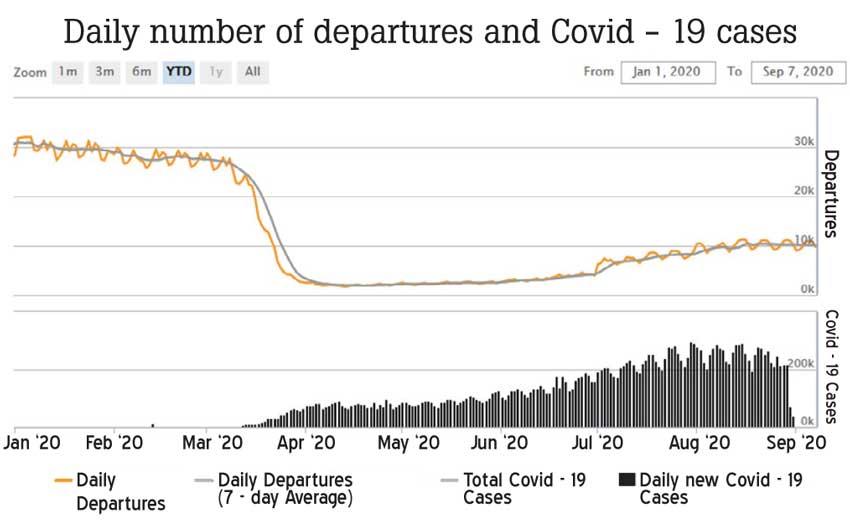16 Sep 2020 - {{hitsCtrl.values.hits}}
 The tourism industry was one of the World’s largest and fastest growing industries just 9 months ago. Today, amidst the throes of the COVID crisis, it is all but devastated and gasping for breath.
The tourism industry was one of the World’s largest and fastest growing industries just 9 months ago. Today, amidst the throes of the COVID crisis, it is all but devastated and gasping for breath.
As the world slowly comes to terms with the deadly virus and the ‘new norm’ emerges, several industries are slowly recovering. However it will be a long uphill battle for tourism to fully recover from the crisis.
This monograph attempts to understand why the tourism industry is so badly hit and why it will take long to recover.
World Tourism 
International tourist arrivals (overnight visitors) worldwide grew 4 percent in 2019 to reach 1.5 billion in 2019, with sustained growth for the 10th successive year (UNWTO World Tourism Barometer 2019), making it the single largest, and fastest growing industry in the world. Asia pacific showed robust above average growth of 4.6 percent.
Earnings from tourism also grew by 4 percent to reach US$ 1.7 trillion, amounting to 10.4 percent of the global GDP.
At the same time tourism being an intense service oriented industry, generates a large number of jobs both in the formal and informal sector. In 2019 it tourism generated 330 million jobs, which is 1 in 10 jobs around the world ( TTC Economic Impact of Tourism).
Sri Lanka Tourism
For Sri Lanka, tourism is one of the important foreign exchange generating industries, being the 3rd  largestsuchforex earner. In 2019 International arrivals amounted to 1.9 m generating US$ 3.6 billion revenues, contributing about 5 percent to the country’s GDP.
largestsuchforex earner. In 2019 International arrivals amounted to 1.9 m generating US$ 3.6 billion revenues, contributing about 5 percent to the country’s GDP.
More importantly tourism provides a range of much needed employment to people, with numbers estimated to be more than 500,000 both in the direct and indirect sector ( WTTC Economic Impact of Tourism Sri Lanka).
This performance is remarkable given the fact that the industry was severely impacted after the April deadly terrorist attacks. Strong recovery was evident with 2019 eventually closing with only an 18 percent drop from 2018 (SLTDA Industry Report).
COVID impact on tourism
There is no doubt that the COVID pandemic has all but completely devastated the tourism industry worldwide. When the pandemic set in early 2020, there was some hope and optimism that this would be over within the year and that tourism would bounce back towards the later part of winter 2020. However, as the pandemic started to explode all over the world, with second waves battering several countries, hope is beginning to fade of a recovery in the near future.

Some impacts on the industry are as follows:
(https://www.unwto.org/impact-assessment-of-the-covid-19)
(https://www.icao.int/sustainability/Documents/COVID-19/ICAO_Coronavirus_Econ_Impact.pdf)
Sri Lanka is in a somewhat more difficult situation due to the closure of borders to foreign travel since mid-March 2020. Consequently there has been zero foreign arrivals to the country from April this year. Hence the socio- economic fallout is somewhat more extensive in Sri Lanka
Prospects for restarting tourism
There are numerous reports that crop up from time to time reporting that ‘this airline is commencing flights’ and ‘that destination is accepting tourists’ and so on. For sure there are a few fights that have recommenced (like some Middle-Eastern carriers) and there are some destinations that have re-opened for tourists (like the Maldives).
However these are exceptions and they are also operating at nowhere near normalcy.
Airlines
The ICAO estimates that airline seat capacity will be about 50 percent less in 2020, and will show a reduction of about 35 percent January to March 2021. IATA predicts that “Global passenger traffic (revenue passenger kilometres or RPKs) will not return to pre-COVID-19 levels until 2024, a year later than previously projected.”
Even though we see several airlines advertising flights to various destinations, they are just a few, and come with many conditions such as pre-requisite COVID tests, lack of reliability of flight schedules due to rapidly changing safety conditions imposed by countries. (Recently a passenger on a conformed flight from Colombo to Melbourne via Doha, was off loaded in Doha, since landing rights in Melbourne had been suspended while the passenger was en-route to Doha from Colombo).
Source countries and destinations
Most tourism destinations have some form of restrictions on travellers entering the country. Some require a CoVid test to be carried out on arrival and also a week after, hotel stays are limited to those establishments that have been declared safe and following correct protocol, etc. And the most serious problem is that these conditions could change at very short notice throwing in disarray all travel plans of visitors.
A few days ago, Britain suddenly imposed compulsory quarantine on all returnees from several Greek island, which led to thousands of tourists holidaying there scrambling to get back before the restrictions came into force
Airports
Most countries in the Asian region in particular, have their airports open only for citizens and residents and not for tourists. Several have some form of restrictions such as quarantine for arriving passengers, a pre-requisite of a COVID negative test, health checks etc.
Hotels
Several hotels in the Asian region are open but catering only for domestic traffic. In most cases this is predominantly weekend traffic, with some hotels even temporary shutting down their operations from Monday to Thursday due to the low occupancy during weekdays.
In Europe there is limited inter- country travel where people are braving sudden changes in restriction, but this travel is between destinations that are geographically very close to each other. People would not want to travel to a long haul destination with so many uncertainties prevailing.
Maldives was one country that did open up for tourists with minimum restrictions. Maldives Immigration revealed that a total of 5,177 tourists arrived in Maldives between July 15 and August 15, the first month following the state’s decision to reopen borders (MV Travel). Considering that the destination welcomed 1.7 million last year, or around 91,000 a month, this is just a ‘drop in the ocean’, but nevertheless an interesting start. The target for July 15 to December 31 has been set at 500,000 ( Skift.Com).
Tourism supply chain is complex
This problem of instability in the tourism sector is because the tourism supply chain has multiple and varied touch points. Each of these touch points of the supply chain has a series of complex variables in this COVID environment, several of which are based on human perception and behaviour.
For example a tourist will decide on whether he wants to travel or not, based on his perceptions, and inputs he receives from all the varied restrictions, regulations. He alone will eventually assess the risk of such travel. The number of airports the tourist has to pass through ( including transit stops) and the varied health protocols prevalent in each of them will also have a bearing on the decision to travel.
The tourism industry supply chain is more complicated than any other industry. Take for example exports. It is reported that the industry is performing well at near normal capacity right now in spite of the pandemic. There are basically 3 touch points in the export industry supply chain. The supplier, freight and buyer. So even in the CoVid environment once the supplier and buyer agree and the mode of freight is agreed upon, the supply chain can work. In addition since the commodity is goods and not people that is moved, there are much less complications due to health restrictions.
In the tourism industry airports, airlines and destinations are constantly reviewing their individual health and safety protocols, and making changes as when necessary at short notice.
It is not sufficient to have one touch point having a reduced risk and restrictions. The whole process has to be free of any possible risk and restrictions.
(The writer is the former President of Tourist Hotels Association of Sri Lanka)
24 Dec 2024 8 hours ago
24 Dec 2024 24 Dec 2024
24 Dec 2024 24 Dec 2024
24 Dec 2024 24 Dec 2024
24 Dec 2024 24 Dec 2024